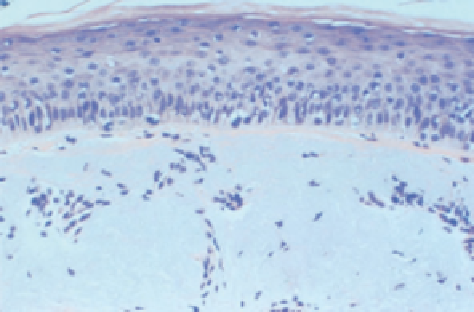Biomedical Engineering Reference
In-Depth Information
(
A
)
(
B
)
Figure 6.10
(
A
) Pretreatment biopsy. (
B
) Long-term biopsies (2 years or more postoperatively) have demonstrated normalization of epidermis, continued gradual
thickening of Grenz zone, and reduction of solar elastosis. In addition, solar elastosis was found to become progressively less homogeneous and amorphous with
a much greater fi brillar content (see also Figure 6.9).
13.0
Vacuolated
12.0
Subboiling
coagulated
11.0
10.0
9.0
Figure 6.11
Zones of thermal damage in tissue instantaneously heated above
70°C but below 100°C. Normal tissue has a temperature of 37°C. Between
this 70°C layer and normal 37°C tissue is a gradient of temperature in which
collagen shrinkage occurs, ideally at 63°C.
8.0
0
1
2
3
4
5
Number of passes with laser
Figure 6.12
Collagen shrinkage as seen per pass with UltraPulse CO
2
laser.
Asterisks
represent rehydration between passes.
Source
: From Ref. 86.
collagen fi bers result in a shrunken matrix on which collagen
remodeling occurs, resulting in the preservation of this tight-
ened skin. That the tightened skin does persist to variable
degrees is confi rmed by study of photographs over time, as
well as by the occurrence of laser-induced ectropion, a condi-
tion of excessive tissue tightening.
Tissue contraction is grossly visible on impact of the
pulsed CO
2
laser with skin during resurfacing being most
profound on the fi rst and second dermal passes after removal
of the epidermis. Although some component of this tissue
contraction is undoubtedly secondary to tissue volume loss
as a consequence of vaporization of tissue water, a large por-
tion is thought to be from collagen contraction. Gardner et al.
(86) found a positive linear correlation between the number
of passes and the degree of skin shrinkage. A linear regres-
sion model showed a 6% size reduction per pass with the
SilkTouch laser and a 5% reduction per pass with the Ultra-
Pulse laser. Rehydrating the tissue between passes resulted in
only slight correction of the shrinkage (Fig. 6.12). Analysis of
a single specimen treated with the SilkTouch laser for fi ve
consecutive passes with rehydration between passes revealed
about 15% reduction on the fi rst pass and a plateau at about
31% reduction after three to fi ve passes. Temperature eleva-
tion in the tissue was approximately 20°C and unchanged
with each pass. Ross et al. (102) observed a positive correla-
tion between contraction of the treated area and both
fl uence and the number of laser passes in their studies on
pig skin.
co
2
laser skin resurfacing
The most important factor in performing CO
2
laser resurfac-
ing is single-pulse laser-tissue interaction (Fig. 6.13). If
vaporization is accomplished in a single pulse, the heat of the
laser-tissue interaction is released in the vapor created, and
thermal diffusion deep into the treated tissue will not occur.
If the tissue cannot be vaporized (i.e., the threshold for
vaporization is not reached), it is critical that the pulse dura-
tion be less than the thermal diffusion time. In this situation,
the laser-tissue interaction site will cool off before there is
time for thermal diffusion to occur. If laser pulses are stacked
one on top of another, additive thermal effects will occur
because of heat retention. For the CO
2
laser, the pulse repeti-
tion rate must be less than an estimated 5 Hz to allow tissue
cooling between pulses and to avoid cumulative thermal
effects (103). The technique used with the Lumenis UltraPulse
is described here.
UltraPulse Technique
When performing resurfacing procedures by hand with a
3-mm collimated beam, it is critical to move the handpiece at
a rate that allows single-pulse laser-tissue interaction, with
minimal overlapping (generally a rate of 4-10 Hz).When
using the CPG, the patterns should not be overlapped, and the






































































